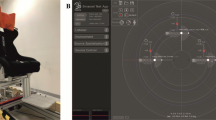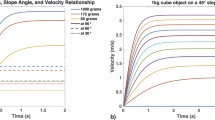Abstract
In the present study, we investigated the effect of weightlessness on the ability to perceive and remember self-motion when passing through virtual 3D tunnels that curve in different direction (up, down, left, right). We asked cosmonaut subjects to perform the experiment before, during and after long-duration space flight aboard the International Space Station (ISS), and we manipulated vestibular versus haptic cues by having subjects perform the task either in a rigidly fixed posture with respect to the space station or during free-floating, in weightlessness. Subjects were driven passively at constant speed through the virtual 3D tunnels containing a single turn in the middle of a linear segment, either in pitch or in yaw, in increments of 12.5°. After exiting each tunnel, subjects were asked to report their perception of the turn’s angular magnitude by adjusting, with a trackball, the angular bend in a rod symbolizing the outside view of the tunnel. We demonstrate that the strong asymmetry between downward and upward pitch turns observed on Earth showed an immediate and significant reduction when free-floating in weightlessness and a delayed reduction when the cosmonauts were firmly in contact with the floor of the station. These effects of weightlessness on the early processing stages (vestibular and optokinetics) that underlie the perception of self-motion did not stem from a change in alertness or any other uncontrolled factor in the ISS, as evidenced by the fact that weightlessness had no effect on the perception of yaw turns. That the effects on the perception of pitch may be partially overcome by haptic cues reflects the fusion of multisensory cues and top-down influences on visual perception.




Similar content being viewed by others
References
Angelaki DE, Hess BJ (2005) Self-motion-induced eye movements: effects on visual acuity and navigation. Nat Rev Neurosci 6(12):966–976
Appelle S (1972) Perception and discrimination as a function of stimulus orientation: the “oblique effect” in man and animals. Psychol Bull 78(4):266–278
Berthoz A (1991) In brain and space, reference frames for the perception and control of movement. Oxford University Press, Oxford, pp 82–111
Bortolami SB, Rocca S, Daros S, DiZio P, Lackner JR (2006) Mechanisms of human static spatial orientation. Exp Brain Res 173:374–388
Cheron G, Godaux E (1987) Disabling of the oculomotor neural integrator by microinjections of kainic acid in the prepositus vestibular nuclear complex of the cat. J Physiol (Lond) 394:267–290
Cheron G, Godaux E, Laune J-M, Vanderkelen B (1986a) Lesions in the cat prepositus complex: effects on the vestibulo-ocular reflex and saccades. J Physiol (Lond) 372:75–94
Cheron G, Godaux E, Vanderkelen G (1986b) Lesions in the cat prepositus complex: effects on the optokinetic system. J Physiol (Lond) 372:95–111
Cheron G, Leroy A, De Saedeleer C, Bengoetxea A, Lipshits M, Cebolla A, Servais L, Dan B, Berthoz A, McIntyre J (2006) Effect of gravity on human spontaneous 10-Hz electroencephalographic oscillations during the arrest reaction. Brain Res 1121(1):104–116
Clarke AH, Grigull J, Mueller R, Scherer H (2000) The three-dimensional vestibulo-ocular reflex during prolonged microgravity. Exp Brain Res 134(3):322–334
Clément G (2003) A review of the effects of space flight on the asymmetry of vertical optokinetic and vestibulo-ocular reflexes. J Vestib Res 13(4–6):255–263
Clément G, Lathan CE (1991) Effects of static tilt about the roll axis on horizontal and vertical optokinetic nystagmus and optokinetic after-nystagmus in humans. Exp Brain Res 84(2):335–341
Clément G, Reschke M (2008) Neuroscience in space. Springer, New York
Clément G, Vieville T, Lestienne F, Berthoz A (1986) Modifications of gain asymmetry and beating field of vertical optokinetic nystagmus in microgravity. Neurosci Lett 63(3):271–274
Clément G, Popov KE, Berthoz A (1993) Effects of prolonged weightlessness on human horizontal and vertical optokinetic nystagmus and optokinetic after-nystagmus. Exp Brain Res 94:456–462
Crawford JD, Vilis T (1993) Modularity and parallel processing in the oculomotor integrator. Exp Brain Res 96:443–456
Dai MJ, Raphan T, Cohen B (1991) Spatial orientation of the vestibular system: dependence of optokinetic after-nystagmus on gravity. J Neurophysiol 66(4):1422–1439
Dai M, McGarvie L, Kozlovskaya I, Raphan T, Cohen B (1994) Effects of spaceflight on ocular counterrolling and the spatial orientation of the vestibular system. Exp Brain Res 102(1):45–56
Droulez J, Darlot C (1989) The geometric and dynamic implications of the coherence constraints in three dimensional sensorimotor interactions. In: Jeannerod M (ed) Attention and performance XIII. Erlbaum, London, pp 495–526
Dyde RT, Jenkin MR, Harris LR (2006) The subjective visual vertical and the perceptual upright. Exp Brain Res 173:612–622
Fuglesang C, Narici L, Picozza P, Sannita WG (2006) Phosphenes in low earth orbit: survey responses from 59 astronauts. Aviat Space Environ Med 77(4):449–452
Gizzi M, Raphan T, Rudolph S, Cohen B (1994) Orientation of human optokinetic nystagmus to gravity: a model-based approach. Exp Brain Res 99(2):347–360
Glasauer S, Mittelstaedt H (1998) Perception of spatial orientation in microgravity. Brain Res Rev 28:185–193
Godaux E, Cheron G (1991) Effects of severance of the vestibular commissural pathway on the neural integrator of the oculomotor system in the cat. Oculomot Control Cogn Process (Schmid and Zambarbieri eds) 2:39–62
Graybiel A, Kellogg RS (1967) Inversion illusion in parabolic flight: its probable dependence on otolith function. Aerosp Med 38(11):1099–1103
Igarashi M, Himi T, Kulecz WB, Patel S, The role of saccular afferents in vertical optokinetic nystagmus in primates (1987) A study in relation to optokinetic nystagmus in microgravity. Arch Otorhinolaryngol 244(3):143–146
Indovina I, Maffei V, Bosco G, Zago M, Macaluso E, Lacquaniti F (2005) Representation of visual gravitational motion in the human vestibular cortex. Science 308:416–419
Kahane P, Hoffmann D, Minotti L, Berthoz A (2003) Reappraisal of the human vestibular cortex by cortical electrical stimulation study. Ann Neurol 54:615–624
Kornilova LN, Kreĭdich IuV, Tarasov IK, Iakovleva IIa (1983) Optokinetic nystagmus and optokinetic resistance of cosmonauts in preflight and postflight periods. Kosm Biol Aviakosm Med 17(4):12–15
Lackner JR (1992) Sense of body position in parabolic flight. Ann N Y Acad Sci 656:329–339
Lackner JR, DiZio P (2000) Human orientation and movement control in weightless and artificial gravity environments. Exp Brain Res 130(1):2–26
Le Seac’h AB, McIntyre J (2007) Multimodal reference frame for the planning of vertical arms movements. Neurosci Lett 423:211–215
Le Seac’h AB, Senot P, McIntyre J (2010) Egocentric and allocentric reference frames for catching a falling object. Exp Brain Res 201(4):653–662
Lipshits M, McIntyre J (1999) Gravity affects the preferred vertical and horizontal in visual perception of orientation. NeuroReport 10:1085–1089
Lipshits M, Bengoetxea A, Cheron G, McIntyre J (2005) Two reference frames for visual perception in two gravity conditions. Perception 34:545–555
Luyat M, Gentaz E (2002) Body tilt effect on the reproduction of orientations: studies on the visual oblique effect and subjective orientations. J Exp Psychol Hum Percept Perform 28:1002–1011
Maffei V, Macaluso E, Indovina I, Orban G, Lacquaniti F (2010) Processing of targets in smooth or apparent motion along the vertical in the human brain: an fMRI study. J Neurophysiol 103(1):360–370
Major G, Baker R, Aksay E, Seung HS, Tank DW (2004) Plasticity and tuning of the time course of analog persistent firing in a neural integrator. Proc Natl Acad Sci USA 101(20):7745–7750
McIntyre J, Zago M, Berthoz A, Lacquaniti FR (2001) Does the brain model Newton’s laws? Nat Neurosci 4:693–694
Miller WL, Maffei V, Bosco G, Iosa M, Zago M, Macaluso E, Lacquaniti F (2008) Vestibular nuclei and cerebellum put visual gravitational motion in context. J Neurophysiol 99(4):1969–1982
Mittelstaedt H (1983) A new solution to the problem of the subjective vertical. Naturwissenschaften 70:272–281
Mittelstaedt H (1999) The role of the otoliths in perception of the vertical and in path integration. Ann N Y Acad Sci 871:334–344
Moscatelli A, Lacquaniti F (2011) The weight of time: gravitational force enhances discrimination of visual motion duration. J Vis 11(4):5, 1–17
NASA’s Extended Duration Orbiter Medical Project (EDOMP), Final Report, 1989–1995, NASA/SP-1999-534
Parker DE, Reschke MF, Arrott AP, Homick JL, Lichtenberg BK (1985) Otolith tilt-translation reinterpretation following prolonged weightlessness: implications for preflight training. Aviat Space Environ Med 56(6):601–606
Popov V, Boyko N (1967) Vision in space travel. Aviatsiya i Kosmonaut 3:73–76
Pouget A, Deneve S, Duhamel JR (2002) A computational perspective on the neural basis of multisensory spatial representations. Nat Rev Neurosci 3:741–747
Pozzo T, Papaxanthis C, Stapley P, Berthoz A (1998) The sensorimotor and cognitive integration of gravity. Brain Res Brain Res Rev 28(1–2):92–101
Proffitt DR, Bhalla M, Gossweiler R, Midgett J (1995) Perceiving geographical slant. Psychon Bull Rev 2:409–428
Redfern MS, Yardley L, Bronstein AM (2001) Visual influences on balance. J Anxiety Disord 15(1–2):81–94
Robinson DA (1989) Integrating with neurons. Ann Rev Neurosci 12:33–45
Sciutti A, Demougeot L, Berret B, Toma S, Sandini G, Papaxanthis C, Pozzo T, Sciutti A, Demougeot L, Berret B, Toma S, Sandini G, Papaxanthis C, Pozzo T (2012) Visual gravity influences arm movement planning. J Neurophysiol 107(12):3433–3445
Senot P, Zago M, Le Seac’h A, Zaoui M, Berthoz A, Lacquaniti F, McIntyre JJ (2012) When up is down in 0 g: how gravity sensing affects the timing of interceptive actions. Neurosci 32(6):1969–1973
Simons JC, Gardner MS (1963) Weightless man: a survey o f sensations and performance while free-floating. Wright-Patterson Air Force Base OH; (USAF Tech. Rep. AMRL-TDR-62-114)
Tagliabue M, McIntyre J (2011) Necessity is the mother of invention: reconstructing missing sensory information in multiple, concurrent reference frames for eye-hand coordination. J Neurosci 31:1397–1409
Task HL, Genco LV (1987) Effects of short-term space flight on several visual functions. In: Bungo MW, Bagian TM, Bowman MA, Levitan BM (eds) Results of the bye sciences DSOs conducted aboard the space shuttle 1981–1986. NASA Technical Memorandum 58280, p 173
Van Erp JB, Groen EL, Bos JE, van Veen HA (2006) A tactile cockpit instrument supports the control of self-motion during spatial disorientation. Hum Factors 48(2):219–228
Vidal M, Bülthoff HE (2009) Storing upright turns: how visual and vestibular cues interact during the encoding and recalling process. Exp Brain Res 200(1):37–49
Vidal M, Lipshits M, McIntyre J, Berthoz A (2003) Gravity and spatial orientation in virtual 3D-mazes. J Vestib Res 13:273–286
Vidal M, Amorim MA, McIntyre J, Berthoz A (2006) The perception of visually presented yaw and pitch turns: assessing the contribution of motion, static, and cognitive cues. Percept Psychophys 68:1338–1350
Young LR, Oman CM, Watt DG, Money KE, Lichtenberg BK (1984) Spatial orientation in weightlessness and readaptation to earth’s gravity. Science 225(4658):205–208
Yu Y, Yank JR, Katsumata Y, Villard S, Kennedy RS, Stoffregen TA (2010) Visual vigilance performance and standing posture at sea. Aviat Space Environ Med 81(4):375–382
Zago M, McIntyre J, Senot P, Lacquaniti F (2009) Visuo-motor coordination and internal models for object interception. Exp Brain Res 192(4):571–604
Acknowledgments
This work was funded by the Belgian Federal Science Policy Office, the European Space Agency (AO-2004, 118), the Belgian National Fund for Scientific Research (F.N.R.S.), the Research Fund of the University of Brussels (U.L.B.), Russian research grant RFBR 11-04-01068 and the French space agency CNES (Centre National des Etudes Spatiales). The authors would like to thank the cosmonauts who participated in this experiment, and the personnel at ESA, CNES, Star City, and Tsoup who made this space experiment possible, especially D. Chaput, E. Lorigny, and V. Grachev. We thank P. Demaret and E. Hortmanns for expert technical assistance.
Author information
Authors and Affiliations
Corresponding author
Rights and permissions
About this article
Cite this article
De Saedeleer, C., Vidal, M., Lipshits, M. et al. Weightlessness alters up/down asymmetries in the perception of self-motion. Exp Brain Res 226, 95–106 (2013). https://doi.org/10.1007/s00221-013-3414-7
Received:
Accepted:
Published:
Issue Date:
DOI: https://doi.org/10.1007/s00221-013-3414-7




